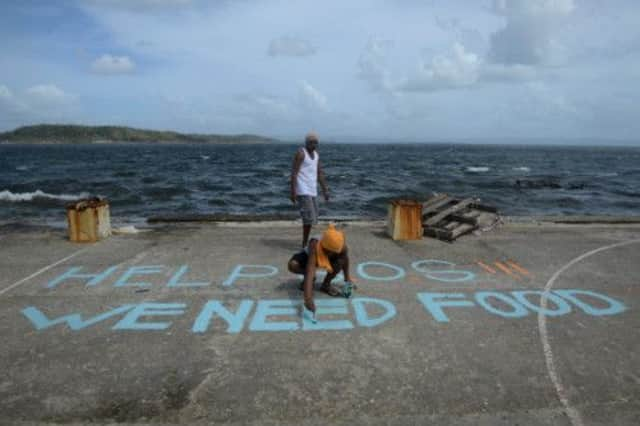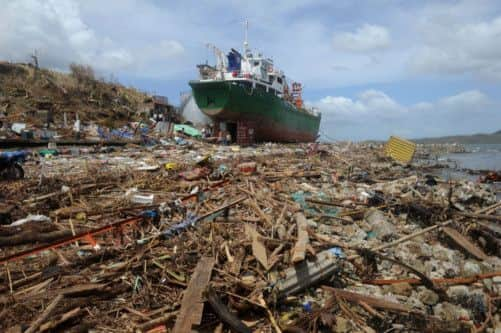Typhoon Haiyan: Official death toll 1,744


The country’s president declared a state of national calamity in an effort to quicken the pace of relief work.
Hundreds of soldiers and police guarded shops to prevent looting, but there was often no-one to carry away the dead.
Advertisement
Hide AdAdvertisement
Hide AdThree days after one of the most powerful storms ever recorded laid waste to the country, the first consignments of aid began arriving yesterday, with two US marine cargo planes touching down in Tacloban, the coastal city annihilated by a huge storm surge. Dozens of residents clamoured for help at the airport gates.


Death toll
The confirmed death toll stood at 1,744 this morning, but about 10,000 people are estimated to have perished, with one mass grave in Tacloban reported to contain up to 500 corpses.
The official death toll is likely to climb rapidly once rescuers reach remote parts of the coast, such as Guiuan, a town in eastern Samar province with a population of 40,000 that was largely destroyed. Baco, a city of 35,000 in Oriental Mindoro province, was 80 per cent under water, the United Nations said, while in Basey, a seaside town in Leyte province, as many as 2,000 people are reported missing.
In a nationwide broadcast, President Benigno Aquino said the government was focusing relief and assistance efforts on Samar and Leyte provinces.
In Tacloban, bodies littered the streets, rotting and swelling in the sun. People walked by covering their noses with rags or old clothes to mask the stench.
Residents gave terrifying accounts of being swept away by a wall of water, the infrastructure overwhelmed by the storm.
Most of the damage and deaths were caused by waves that inundated towns, washed ships ashore and swept away villages in scenes reminiscent of the 2004 Indian Ocean tsunami.
‘Washed away’
Jean Mae Amande, 22, said she was washed several miles from her home by the surge of water. The current ripped her out to sea before pushing her back to shore, where she was able to cling to a tree and grab a rope thrown from a boat. An old man who had been swimming with her died when his neck was gashed by an iron roof, she said. “It’s a miracle that the ship was there,” Ms Amande said.
Advertisement
Hide AdAdvertisement
Hide AdUS Marines Brigadier General Paul Kennedy took a helicopter flight over the city. He said the destruction was widespread: “I don’t believe there is a single structure that is not destroyed or severely damaged in some way.”
International aid agencies said relief resources were stretched thin after an earthquake in central Bohol province last month and displacement caused by a conflict with Muslim rebels in southern Zamboanga province.
Richard Gordon, head of the Philippine Red Cross, described the situation as “absolute bedlam”. He said: “We’re beginning just to bring in the necessary food items.”
Jane Cocking, the humanitarian director for Oxfam, said her colleagues witnessed “complete devastation” as “entire parts of the coastline just disappeared”.
Relief
Some 21 countries have pledged to send relief, including Britain. The Disasters Emergency Committee, made up of 14 UK charities, said its members were responding to the crisis but the scale of the destruction meant there was “huge unmet need”.
The Philippine National Red Cross said people were not prepared for a storm surge. Gwendolyn Pang, its executive director, said: “America, which was prepared and very rich, still had a lot of challenges at the time of Hurricane Katrina, but what we had was three times more than what they received.”
There were, however, some remarkable stories of survival. Emily Ortega, 21 and about to give birth, had taken shelter with her husband in an evacuation centre. However, the building was devastated by the storm, forcing them to swim to survive.
They reached safety at Tacloban’s airport, where she gave birth to a healthy baby girl, named Bea Joy Sagales. Her arrival drew applause from others in the airport and military medics who assisted in the delivery.
Scots charity calls for aid to help recovery
Advertisement
Hide AdAdvertisement
Hide AdA SCOTTISH charity yesterday launched an emergency appeal to help millions of people in the Philippines affected by Typhoon Haiyan.
The drive by the Scottish Catholic International Aid Fund (Sciaf) drive is designed to support partner agencies Caritas Philippines and Catholic Relief Services, which are already in the country as part of a vast worldwide relief operation.
Sciaf, the official aid and international development charity of the Catholic Church in Scotland, said clean water, food, shelter and medicine were among the immediate priorities.
Lorraine Currie, Sciaf’s head of international programmes, said: “This is a major disaster which will require a huge humanitarian response … I would urge everyone to give whatever they can.”
Father Edwin Gariguez, executive secretary of Caritas Philippines, said the magnitude of the typhoon went beyond all expectations. He said: “Casualties are increasing day by day. There are dead bodies everywhere. People are traumatised.”